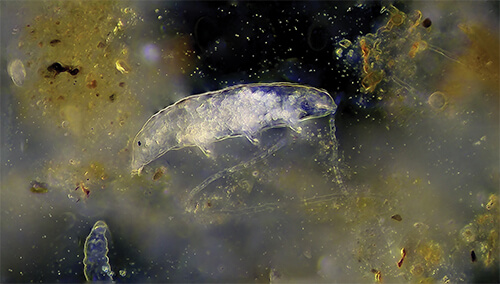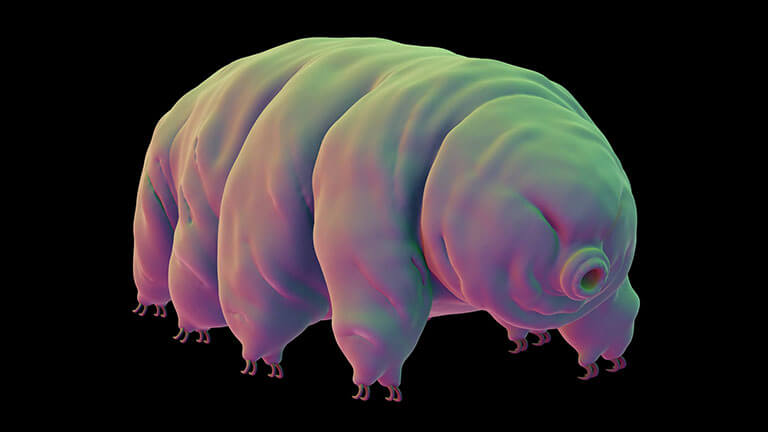Scientists studying these extreme survivors are beginning to uncover their secrets, providing potential solutions for surviving difficult environmental conditions
Tardigrades are miniscule aquatic animals, only about the size of the period at the end of this sentence. Yet they are renowned for their ability to survive a number of punishing physical extremes. Now, scientists studying tardigrades are beginning to uncover the secrets of their super survival skills. In the process, they are discovering unique biological mechanisms that may help to solve real-world, human health problems.
Under the microscope, their looks are unassuming, and may even be considered cute. The tardigrade’s chubby appearance has earned it the nicknames “water bear” and “moss piglet” (Figure 1). There are at least 1200 species of tardigrades, and they can be found almost everywhere, from the deep ocean to suburban backyards.
Despite being so tiny, they are extremely resilient. While all tardigrades need water to survive, some species can tolerate almost complete dehydration. They basically stop all metabolism and enter a state of suspended animation in which they can remain for years or decades. When exposed to water again, they spring back to life [1].
In their desiccated state, tardigrades are able to withstand a litany of extraordinary environmental conditions. They can go for days or weeks with little to no oxygen; be frozen just above absolute zero, the point at which all molecular motion stops; be heated up past the boiling point of water; survive thousands of times as much radiation as a human could; tolerate the extreme pressures at the bottom of oceans; and even survive direct exposure to the vacuum of space [2].

DNA protection
In 2016, a team from the University of Tokyo sequenced the genome of a tardigrade species (Ramazzottius varieornatus) known to survive high doses of radiation. They discovered a novel protein that appears to protect DNA from damage and named it damage suppressor, or Dsup. Dsup is unusual in that it is an intrinsically disordered protein (IDP), meaning that it lacks a stable, 3-D structure. The research team found that Dsup works to minimize damage inflicted on the DNA. When human cultured cells grown in a laboratory were engineered with Dsup, they showed about 40% more tolerance against X-ray radiation [2].
A few years later, researchers from the University of California at San Diego, San Diego, CA, USA, uncovered the molecular explanation for how Dsup protects cells from radiation. Their biochemical analyses revealed that the protein binds to chromatin, the form of DNA found inside cells. Once bound to chromatin, Dsup forms a protective cloud that shields DNA from hydroxyl radicals, which are produced by X-rays [3].
Grisel Cruz-Becerra, a biologist and member of the UC San Diego research team (Figure 2), says these findings may one day help scientists develop cell lines with more durability and longevity. “It could be a great benefit having the types of cell lines that have been used for the production of biologics expressing the Dsup protein to potentially ameliorate the effect of cellular stress that happens under normal growing conditions,” says Cruz-Becerra.
However, she cautions that we still know very little about tardigrade proteins. “A better understanding of how Dsup works in tardigrades and what it does in human cells is necessary before we can think about translating this knowledge to more direct applications in biotechnology and medicine,” she says.

Searching for protective proteins
Tardigrade IDPs also piqued the interest of Pamela Silver, a synthetic biologist at Harvard Medical Institute and the Harvard Wyss Institute
(Figure 3). In 2018, her team was awarded a grant from the Defense Advanced Research Projects Agency (DARPA) to study tardigrade proteins. DARPA was looking for novel solutions to stabilizing traumatic injuries in combat zones [4].
“The time from when one is wounded to when one gets to the hospital is a critical time,” says Silver. “In medicine, that window of time is called ‘the golden hour’ and we would like to extend it for as long as possible.” The ultimate goal of the project is to develop new protein-based compounds that could stop bleeding and cell death in traumatic injuries, allowing more time for transportation and treatment.
Silver and her colleagues tested a library of approximately 300 proteins, some of which were found in nature and others that were designed to have properties similar to tardigrade IDPs. The researchers tested the proteins under several conditions, including protecting cells from programmed cell death, or apoptosis, and they found a number of candidate proteins that performed well.
“We are continuing to examine other phenomena that these proteins could impact,” says Silver. “For example, the exposure to hypoxia is medically relevant for conditions such as heart attack and stroke, and also potentially relevant to the mechanism by which these proteins work in tardigrades. We have been looking at the ability of these proteins to have an effect on low oxygen conditions and we have similarly found candidates.”

at the Harvard Medical Institute and the Harvard Wyss Institute. Her team was awarded a grant
from DARPA to study tardigrade proteins.
(Photo courtesy of the Wyss Institute.)
Better protein preservation
At the University of Wyoming, biologist Thomas Boothby, also funded by DARPA, is trying to figure out how tardigrade IDPs help the animals survive desiccation, and how those insights might be applied to human health.
Boothby wondered if tardigrade IDPs could potentially help with preserving vaccines and other protein-based pharmaceuticals that rely on the “cold chain.” This refers to the continual chain of refrigerators and freezers needed to stabilize these pharmaceuticals from manufacture to shipping and storage. Boothby says that we might take the cold chain for granted, but in remote or developing parts of the world, or in crisis situations like natural disasters, keeping vaccines or other pharmaceuticals cold can be difficult or even prohibitive.
His team is looking at whether tardigrade IDPs may be one day used to protect protein-based pharmaceuticals. “By adapting tricks that tardigrades use to stabilize their biological material when they dry out, and applying them to vaccines and other pharmaceuticals, we hope to be able to stabilize those life-saving medicines in a dry state without the need for refrigeration,” says Boothby.
Already, preliminary work provides encouraging evidence. Boothby and his team have compared the ability of tardigrade IDPs to preserve vaccines to that of Food and Drug Administration (FDA)-approved protectants. They found that IDPs protect protein-based pharmaceuticals about 10 times more efficiently than current methods [5].
Boothby also hopes to eventually apply the properties of tardigrade IDPs to the stabilization of whole human blood. His ultimate goal is to make blood in a dry state that can last longer than the current two months at ambient or even hot temperatures. Such a product could be carried by ambulances or soldiers and stored for long periods of time.
Tardigrades in space
In addition, Boothby is working with the National Aeronautics and Space Administration (NASA) to see if tardigrades can offer any insights into making space travel easier on humans.
This summer, a group of tardigrades from Boothby’s lab were delivered to the International Space Station, where they will undergo experiments aimed at understanding changes to their gene expression as they experience the stressful conditions of space. These stresses include lack of gravity and exposure to radiation, both of which can wreak havoc on the human body [6].
“Humans do not typically do well being in space for a long time, let alone over generations,” says Boothby. “But tardigrades seem to handle it well, going about their normal lives and even producing healthy offspring in space.”
Tardigrades have made the journey to space before. In 2007, scientists launched two species of tardigrades into orbit and exposed them to the cold vacuum of space, with no protection from the lack of pressure or the punishing radiation. Those tardigrades proved robust—not only surviving the stressful conditions, but later returning to their normal lives and reproducing [1].
By learning more about how tardigrades survive under stressful spaceflight conditions, we may be able to eventually develop therapies or countermeasures that would allow humans to have a longer and more productive time in space. Boothby and his colleagues will study the fourth generation of tardigrades grown in space and look at which ones of their genes get turned on and off when exposed to this environment. They suspect that the pattern of gene expression in these tardigrades may provide clues to how they cope with the stress of microgravity and radiation.
Boothby says that he is inspired by the solutions that nature has come up with over billions of years of evolution. By looking to nature, he thinks we may find new strategies for solving human problems. “Oftentimes, when we humans identify a societal or technological problem that seems difficult or even insurmountable, if we take a step back and look at nature, other organisms have had to deal with many of the same types of issues for which we are searching for solutions,” says Boothby. “Evolution has actually come up with a lot of creative, effective solutions to a lot of problems already.”
“Tardigrades are these natural oddities in that they can survive in all these bizarre, stressful conditions. By studying the fundamental biology of organisms like tardigrades, we may be able to solve a lot of real-world problems.” <
References
- S. Borenstein, “Science says: Tiny ‘water bears’ can teach us about survival,” AP News, Mar. 20, 2019. [Online]. Available: https://apnews.com/article/science-ap-top-news-health-animals-biology-eef745143f4a4b0fa6aedb250544aabb
- T. Hashimoto et al., “Extremotolerant tardigrade genome and improved radiotolerance of human cultured cells by tardigrade-unique protein,” Nature Commun., vol. 7, p. 12808, Sep. 2016, doi: 10.1038/ncomms12808.
- C. Chavez et al., “The tardigrade damage suppressor protein binds to nucleosomes and protects DNA from hydroxyl radicals,” eLife, vol. 8, p. e47682, 2019, doi: 10.7554/eLife.47682.
- E. Pesheva, “The master of survival,” Harvard Gazette, Jan. 25, 2019. [Online]. Available: https://
news.harvard.edu/gazette/story/2019/01/could-an-extremophile-hold-the-secret-to-treatment-of-devastating-injuries/ - S. Bennett, “After conquering space, water bears could save the global vaccine and blood supply,” Nova Next, Mar. 6, 2019. [Online]. Available: https://www.pbs.org/wgbh/nova/article/after-conquering-space-water-bears-could-save-global-vaccine-and-blood-supply/
- “UW tardigrade research to begin on international space station,” UW News, Jul. 12, 2021. [Online]. Available: https://www.uwyo.edu/uw/news/2021/07/uw-tardigrade-research-to-begin-on-international-space-station.html



